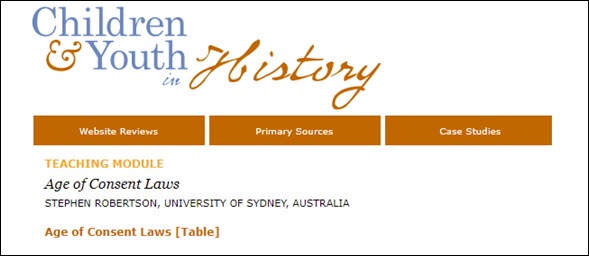A isn’t always A
The age of consent isn’t the same thing as the age of consent.
Really.
Yes, The Legal Genealogist knows that’s confusing.
So let’s try to untangle it.
The issue came up yesterday on Facebook where the question was the ages of the family members who were the youngest at the times of their marriages. A poster had come across an 11-year-old bride and was quite surprised.
So several folks chimed in with a wonderful table showing the age of consent in all the states of the United States and elsewhere in the world as of 1880, 1920 and 1987.1

The table is actually shocking, with age 7 shown as the age of consent in Delaware in 1880, age 10 in 37 other states, and age 12 — the highest for any U.S. state — in the District of Columbia and nine other states.
Now… this would still be shocking even if we hadn’t wondered a bit about listing information for 47 states when the United States didn’t have 47 states in 1880.
Even if some of these came from territorial laws, I mean — seriously? — a seven-year-old getting married in Delaware in 1880? A 10-year-old in New York or New Jersey?
And no matter how you cut it, these ages are shocking.
But not the way you might think.
Because this table showing the age of consent doesn’t actually show the age of consent.
Not when it comes to the age of consent for marriage.
And therein, of course, lies the rub.
The problem, you see, is that term “age of consent” is inherently ambiguous in the law.
Yes, in the context of family law, age of consent absolutely does mean “the age one can give meaningful consent to enter into a marriage.”2
But that’s not the only legal context in which the term is used. It’s also very much a term in the criminal law — and in that context, it means “the age at which a person is considered to be legally competent to consent to sexual acts. Consequently, an adult who engages in sexual activity with a person younger than the age of consent is unable to legally claim that the sexual activity was consensual, and such sexual activity may be considered child sexual abuse or statutory rape.”3
And that’s the context of the table and its shockingly low ages in 1880.
Looking, for example, at Alabama, where the table says the age of consent is 10, the Alabama Code of 1876 says quite clearly that the age “required to give validity to a marriage” is 17 for a boy and 14 for a girl.4
You don’t find that reference to the age of 10 until you’re in the criminal sections of the code, where it appears in a section entitled “Carnal knowledge of female under 10 years of age.”5
Context matters, and the context of the table has nothing whatsoever to do with the age for a valid marriage. This isn’t family law, it’s criminal law.6
In the law, at least, A isn’t always A.
And this is an example where A isn’t the same thing as A at all.
Cite/link to this post: Judy G. Russell, “Same not same,” The Legal Genealogist (https://www.legalgenealogist.com/blog : posted 10 June 2021).
SOURCES
- Stephen Robertson, “Age of Consent Laws–Table,” Teaching Module, Children & Youth in History, Center for History and New Media, George Mason University (https://chnm.gmu.edu/cyh/ : accessed 10 June 2021). ↩
- See Wex, Legal Information Institute, Cornell Law School (https://www.law.cornell.edu/wex : accessed 10 June 2021), “age of consent.” ↩
- Wikipedia (https://www.wikipedia.com), “Age of consent,” rev. 7 May 2021. ↩
- §2672, “Age required to give validity to a marriage,” in Wade Keyes and Fern. M. Wood, compilers, Code of Alabama, 1876 (Montgomery : Barrett & Brown, State Printers, 1877), 641; digital images, Google Books (https://books.google.com/ : accessed 10 June 2021). ↩
- Ibid., §4306, at 913. ↩
- The other information with the table says so. There’s an introductory article that couldn’t be clearer. See Stephen Robertson, “Age of Consent Laws–Introduction,” Teaching Module, Children & Youth in History, Center for History and New Media, George Mason University (https://chnm.gmu.edu/cyh/ : accessed 10 June 2021) (“In western law, the age of consent is the age at which an individual is treated as capable of consenting to sexual activity. Consequently, any one who has sex with an underage individual, regardless of the circumstances, is guilty of a crime”). ↩



“… inherently ambiguous in the law…” Don’t you just love it? Where would we lawyers be if it weren’t for ambiguity?
Answer: most likely unemployed.
Ambiguity — the lawyer’s full employment act!